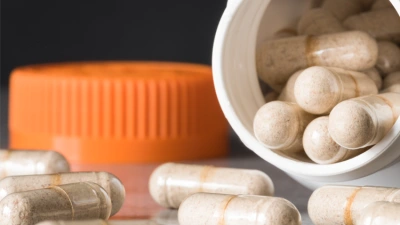FIBER 101
Which Dietary Fiber Supplement Is Best for Me and My Diet?
90 percent of Americans don’t get enough fiber in their diet1. Getting enough dietary fiber is important to maintain your digestive wellness, but it can be difficult to eat the daily recommended amount of high-quality, fiber-rich foods. On average, it takes about 7 apples, 14 large carrots, 14 bananas or 15 cups of broccoli to reach the recommended amount of fiber Americans from 18 to 50 years old should consume each day.
Dietary fiber supplements are a fast and easy way to increase fiber without significantly increasing calories, carbs, or sugar. So, if you feel that you’re not getting enough fiber in your diet, read on to learn why you should be taking fiber supplements, and which supplement you should be taking.
Aren’t all fiber supplements the same?
No! Not all fiber is the same. Before we talk about types of fiber, let’s take a step back and talk about what dietary fiber is and why it’s important to include in your diet. Fiber is a complex carbohydrate that your body isn’t able to digest or absorb and is categorized by two main types: soluble fiber and insoluble fiber.
Soluble fiber will dissolve in liquids. Some dissolve entirely and some thicken the liquid, even going as far as to form a gel-like material.
Insoluble fiber (which can also be called “roughage”) does not dissolve in liquids and won’t form a gel.
Beyond solubility, there are other characteristics that help categorize the different types of fiber: viscosity, gel formation, and fermentation.
-
Solubility tells you if a fiber will dissolve in water (which solubles do) or remain whole (as insolubles do)
-
Viscosity tells you if a soluble fiber “thickens” the liquid it mixes in or gets larger when it’s wet
-
The gel-forming ability of some soluble viscous fiber refers to the fiber’s ability to absorb and hold liquid when it gets wet.
-
Fermentation refers to how quickly and how much a fiber will be broken down by the natural bacteria in the gut
The four characteristics typically divide fiber sources into three categories:
HEALTH BENEFITS OF DIFFERENT FIBERS | INSOLUBLE | SOLUBLE NON-VISCOUS | SOLUBLE VISCOUS | ||||
|---|---|---|---|---|---|---|---|
Wheat Bran (food Sources) | Wheat Dextrin (Benefiber) | Inulin (Fiber choice) | Calcium Polycarphil (FiberCon©) | Methyl- cellulose (Quaker Oats©) | B-glucan (Quaker Oats©) | Psyllium (Metamucil©) | |
Poorly Fermented | Fermented | Fermented | Not Fermented | Not Fermented | Fermented | Not Fermented | |
Helps maintain healthy blood glucose levels* |  |  |  |  |  |  |  |
Reduces the risk of Cardiovascular Disease by lowering elevated serum cholesterol levels+ |  |  |  |  |  |  |  |
Treats occasional constipation |  |  |  |  |  |  |  |
What are good sources of fiber?
There are many sources of fiber in each of the four categories above. One place to start is by eating more fiber rich foods—fruits, vegetables, whole grains, beans and other legumes, and seeds and nuts. You can also try foods that have fiber added to them, including some breakfast products and snack foods. Avoid overly processed or refined foods, which are usually lower in fiber since the processing can remove natural fiber.
If you’re finding it hard to get enough fiber from food alone, fiber supplements can help you get the recommended daily amount. There are many types of fiber supplements available, so it comes down to choosing the benefits of fiber you want. Remember that each fiber can have pros and cons depending on how the fiber acts and is processed by the body. We’ve included a chart below to help you compare common types of fiber.
As you can see, there are different benefits to each type of fiber. Depending on the benefits you’re looking for, you may find it easier or more convenient to take a fiber supplement that offers multiple benefits.
If you are looking for multiple benefits from one fiber, you may decide that plant-based psyllium husk is right for you. Psyllium husk comes from the seeds of the plantago ovato plant, a medicinal plant commonly found in southern Asia.
90 percent of Americans don’t get enough fiber in their diet.(1)
COMMON FIBERS | CHARACTERISTICS | TYPE OF FIBER | GEL FORMATION |
|---|---|---|---|
Wheat Bran(food sources) | -Does not dissolve in water | Insoluble |  |
Wheat Dextrin(Benefiber©) | -Nonviscous, readily fermented | Soluble |  |
Calcium Polycarbophil (FiberCon©) | -Viscous, non gel-forming, | Soluble |  |
B-glucan(Quaker Oats©) | -Viscous, gel-forming, | Soluble |  |
Psyllium((Metamucil©) | -Viscous, gel-forming, | Soluble |  |
One thing to remember is that most fibers in foods are not exclusively soluble or insoluble, so the fiber you’re considering may have more than one of these characteristics.
What is psyllium husk?
As you can see in the chart above, psyllium fiber, like the fiber found in Metamucil, is a soluble, viscous, gel-forming fiber that doesn’t ferment. Not fermenting means that no gas is released, which helps it remain in your gut to soften your stool and trap and remove the waste that weighs you down*, leaving you feeling lighter and more energetic**. In addition to helping with occasional constipation, studies on psyllium husk have revealed other benefits, including lowering cholesterol to promote heart health†, helping to maintain healthy blood sugar levels*, and extending feelings of fullness after eating*.
Avoid overly processed or refined foods, which are usually lower in fiber since the processing can remove natural fiber.
